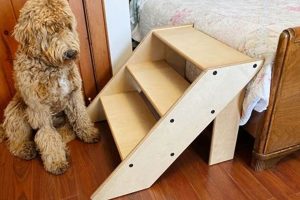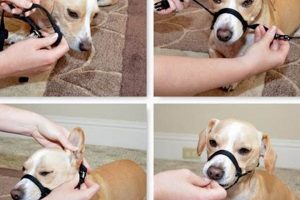Homemade interactive playthings designed to stimulate a canine’s mind and body represent a cost-effective and customizable approach to pet care. These items, created from readily available household materials, encourage problem-solving, foraging, and physical activity, offering mental and physical engagement. An example includes a puzzle feeder crafted from a muffin tin and tennis balls, requiring the dog to manipulate the balls to access the food underneath.
Providing mental and physical stimulation through these activities can significantly improve a dog’s overall well-being. These activities reduce boredom, mitigate destructive behaviors often stemming from under-stimulation, and promote cognitive function. Historically, owners have adapted materials for animal play, but the formal recognition of enrichment’s benefits and accessible instructions have recently popularized do-it-yourself approaches.
The subsequent sections will detail specific construction methods for various categories, including puzzle feeders, snuffle mats, and interactive treat dispensers. Considerations for safety, durability, and appropriate difficulty levels for differing canine breeds and temperaments will also be addressed.
DIY Enrichment Toys
The following guidelines ensure safe and effective implementation of homemade interactive devices for canines. Adherence to these points can minimize potential hazards and maximize the benefits of enrichment activities.
Tip 1: Prioritize Material Safety: Select non-toxic, durable materials resistant to shredding or ingestion. Avoid small parts that could pose a choking hazard. Inspect items regularly for damage and discard them promptly if compromised.
Tip 2: Tailor Difficulty to the Dogs Ability: Begin with simple designs and gradually increase the complexity as the dog becomes more proficient. Observe the dogs engagement level and adjust the challenge accordingly to prevent frustration.
Tip 3: Supervise Initial Interactions: Closely monitor the dog’s initial use of each new item to ensure safe and appropriate interaction. Intervene if the dog becomes overly aggressive or attempts to destroy the device.
Tip 4: Incorporate Variety: Rotate between different activities to maintain interest and prevent boredom. Introduce new constructions periodically to provide continued mental stimulation.
Tip 5: Consider Dietary Restrictions: When using food-based puzzles, factor in the dogs daily caloric intake to prevent overfeeding. Utilize healthy treat options and adjust meal portions accordingly.
Tip 6: Ensure Proper Hygiene: Regularly clean food-dispensing items to prevent bacterial growth and maintain sanitary conditions. Use pet-safe cleaning solutions and allow items to dry thoroughly before reuse.
Tip 7: Account for Breed and Temperament: Adapt designs based on the dog’s breed characteristics and individual personality. For instance, scent-oriented breeds may benefit from snuffle mats, while high-energy breeds may require more physically demanding activities.
The implementation of these tips will help to create effective and long-lasting enrichment opportunities for a canine companion. Prioritizing safety and adjusting to the dog’s ability are paramount to success.
Next, the concluding section will summarize the benefits of these activities and offer final considerations for owners seeking to enhance their dog’s well-being.
1. Safety
The creation of interactive devices for canines necessitates a paramount focus on safety. The selection of materials and design features directly influences the risk of injury or illness, demanding careful consideration throughout the construction process.
- Material Toxicity
The utilization of non-toxic materials is crucial to prevent poisoning. Dogs may ingest components during play, making materials like untreated wood, food-grade plastics, and natural fabrics preferable to those containing potentially harmful chemicals. For example, avoiding paints or adhesives with lead or volatile organic compounds minimizes the risk of adverse health effects if ingested.
- Choking Hazards
The presence of small, detachable parts or easily shredded materials poses a significant choking hazard. Constructions should be robust and free of elements that a dog could readily detach and swallow. Items like buttons, plastic eyes, or loosely woven fabrics are generally unsuitable. Instead, choose sturdy, single-piece constructions or securely attached components.
- Sharp Edges and Protrusions
Any sharp edges or protruding elements represent a potential source of cuts or abrasions. Designs should prioritize smooth surfaces and rounded corners. Sanding rough edges, covering exposed screws, and using blunt fasteners contribute to a safer playing environment.
- Durability and Structural Integrity
A well-constructed toy maintains its structural integrity during vigorous play. Fragile constructions can break apart, creating sharp fragments or releasing small parts. Regularly inspecting and reinforcing items, especially those subjected to heavy use, helps prevent failures that could lead to injury. Choosing appropriately strong materials and secure fastening methods is essential for long-term safety.
These considerations collectively emphasize the importance of proactive risk assessment in the creation process. By prioritizing non-toxic materials, minimizing choking hazards, eliminating sharp edges, and ensuring structural integrity, individuals can significantly reduce the potential for harm. These safety measures are essential for providing a beneficial and secure play experience for canine companions.
2. Durability
Durability constitutes a critical attribute of homemade interactive playthings for canines. The longevity and safety of these constructions directly correlate with their ability to withstand repeated use, ensuring sustained mental and physical stimulation while minimizing potential hazards.
- Material Selection and Resistance to Chewing
The choice of materials significantly impacts the item’s resistance to canine chewing behaviors. Durable substances such as heavy-duty canvas, thick rope, or specific types of pet-safe, high-density plastics are preferable to softer, more easily destructible materials. For instance, puzzle feeders crafted from thin cardboard are unlikely to withstand prolonged use compared to those constructed from robust plastic containers. The inherent material properties must align with the anticipated level of canine interaction.
- Joint Strength and Construction Integrity
The method of assembly and the strength of the resulting joints are integral to overall durability. Secure stitching for fabric items, strong adhesives for bonded components, and robust fasteners for assembled structures are essential. A snuffle mat with loosely attached fabric strips will quickly degrade, whereas one with tightly sewn strips exhibits greater longevity. Weak joints represent a potential failure point, reducing the lifespan and potentially creating hazards.
- Resistance to Environmental Factors
Outdoor use necessitates resistance to environmental factors such as moisture, sunlight, and temperature fluctuations. Materials susceptible to degradation under these conditions will compromise the item’s lifespan and safety. Treated wood, weather-resistant fabrics, and UV-resistant plastics are preferable for outdoor constructions. An example includes a toy left outdoors, becoming brittle and prone to splintering after prolonged exposure to sunlight, underscoring the importance of material selection.
- Design for Longevity and Repairability
Designing with longevity in mind involves considering potential wear points and incorporating features that enhance repairability. Reinforcing stress areas, using replaceable components, and creating designs that facilitate disassembly for cleaning and maintenance extend the item’s usable life. For instance, a treat-dispensing toy with easily replaceable caps or reinforced seams offers a longer period of use compared to a sealed, non-repairable design.
The interplay of these elements determines the overall durability of do-it-yourself canine enrichment toys. By prioritizing appropriate materials, robust construction techniques, and consideration for environmental factors, creators can maximize the lifespan and safety of these valuable tools, contributing to sustained canine well-being and engagement.
3. Stimulation
Mental and physical stimulation is a foundational element of canine well-being, and do-it-yourself enrichment devices offer a customizable avenue for providing varied and engaging experiences. These items challenge a dog’s cognitive abilities and physical dexterity, mitigating boredom and promoting a more balanced temperament.
- Cognitive Challenge and Problem-Solving
Interactive playthings compel dogs to engage in problem-solving to access rewards or manipulate the device. Puzzle feeders, for example, require strategic thinking to dislodge food, activating cognitive pathways and fostering mental acuity. Real-life instances include a dog figuring out how to rotate a container to release treats, enhancing its problem-solving capabilities. Such activities translate to improved adaptability and reduced cognitive decline.
- Sensory Engagement and Exploration
These activities can stimulate a canines senses through various textures, scents, and sounds. Snuffle mats encourage olfactory exploration as dogs use their sense of smell to locate hidden treats. Examples include incorporating different fabrics with varying tactile properties into a single device, enriching the sensory experience. Heightened sensory engagement reduces stress and promotes mental well-being.
- Physical Activity and Exercise
Devices that necessitate movement or manipulation contribute to a dog’s daily exercise quota. Interactive treat dispensers that require rolling or chasing encourage physical activity, particularly beneficial for breeds prone to inactivity. A real-world example involves a toy designed to be pushed around the floor, dispensing treats as it moves, promoting physical exertion. Sufficient physical activity mitigates behavioral problems associated with pent-up energy.
- Reduction of Boredom and Destructive Behaviors
Insufficient stimulation frequently leads to boredom, manifesting as destructive behaviors such as excessive chewing or digging. Providing consistent access to engaging do-it-yourself enrichment activities can redirect a dog’s energy into constructive outlets. A dog that previously chewed furniture, for example, might redirect its chewing urges towards a durable interactive toy, mitigating destructive tendencies and preserving household items.
These facets collectively underscore the significance of stimulation in promoting a healthy and balanced canine lifestyle. Do-it-yourself enrichment devices provide a versatile and adaptable means of addressing this crucial need, fostering cognitive development, sensory engagement, physical activity, and behavioral well-being. These benefits culminate in a happier and healthier canine companion.
4. Accessibility
Accessibility, within the context of homemade interactive playthings for canines, pertains to the ease with which a dog can engage with and derive benefit from the device. The design must consider the dog’s physical capabilities, cognitive understanding, and sensory perception to ensure effective interaction. A toy rendered too difficult or physically demanding negates its intended purpose, potentially leading to frustration or abandonment. Conversely, an overly simplistic toy may fail to provide sufficient stimulation. An example is a puzzle feeder requiring precise paw movements unattainable by a dog with limited mobility, rendering the toy inaccessible. The principle of accessibility, therefore, represents a cornerstone of effective device construction.
The practical application of this principle involves careful evaluation of a dog’s breed characteristics, age, physical condition, and temperament. A toy intended for a small breed, such as a Chihuahua, should differ significantly in size and complexity from one designed for a larger breed like a Labrador Retriever. Similarly, a senior dog with arthritis may require a device that minimizes physical exertion and emphasizes olfactory stimulation, such as a low-lying snuffle mat. Furthermore, initial introductions to the toy should be closely supervised, with adjustments made to increase or decrease difficulty as needed, ensuring the dog remains engaged and successful. Failure to adequately address accessibility constraints can lead to disinterest and non-compliance, undermining the potential benefits of the enriching activity.
Ultimately, accessibility is not a static attribute but rather a dynamic consideration requiring ongoing observation and adaptation. Owners should continuously assess their dog’s interaction with the device, modifying the design or method of use as necessary to maintain optimal engagement. Challenges may arise from changes in the dog’s physical condition or cognitive abilities over time, necessitating further adjustments. Embracing a flexible and responsive approach ensures that the homemade interactive plaything remains a valuable tool for promoting canine well-being, supporting long-term mental and physical health.
5. Customization
The adaptability of do-it-yourself interactive devices represents a primary advantage over commercially manufactured options. Tailoring these enrichment items to meet specific canine needs optimizes engagement and enhances overall effectiveness.
- Breed-Specific Adaptations
Canine breeds exhibit diverse physical characteristics and behavioral tendencies, necessitating adjustments in toy design. Scent hounds, for instance, benefit from puzzle feeders that emphasize olfactory stimulation, while herding breeds may respond positively to toys that encourage controlled chasing behavior. Construction dimensions should align with the dogs size and physical capabilities to ensure safe and effective interaction. For example, large breeds require durable materials and robust construction to withstand forceful play.
- Individual Temperament Considerations
Each dog possesses a unique personality and learning style, influencing its preference for certain activities. Anxious or timid dogs may benefit from less challenging puzzles that offer immediate gratification, while confident and assertive dogs thrive on complex problem-solving tasks. Observing the dog’s reactions to different stimuli informs the design process, facilitating the creation of engaging and appropriately challenging enrichment opportunities. For example, a dog with a strong prey drive may enjoy toys that mimic hunting scenarios, providing a satisfying outlet for innate instincts.
- Physical Limitations and Special Needs
Dogs with physical limitations, such as arthritis or impaired vision, require modified toy designs to accommodate their specific needs. Raised feeding platforms or puzzle feeders with simplified access points allow dogs with mobility issues to participate comfortably. Toys with contrasting colors and strong scents may enhance engagement for visually impaired dogs. Safety considerations are paramount when adapting toys for special needs dogs, ensuring the absence of sharp edges or small parts that could pose a hazard.
- Progressive Difficulty Adjustment
Do-it-yourself constructions enable incremental adjustments to difficulty as the dogs skills progress. Initial designs can incorporate simple puzzles that gradually increase in complexity as the dog masters each stage. This progressive approach sustains engagement and prevents boredom, fostering continuous learning and mental stimulation. For example, puzzle feeders with removable compartments allow owners to add or subtract challenges as the dog becomes more adept at accessing the rewards.
The multifaceted nature of customization underscores its significance in optimizing the benefits of interactive canine playthings. By tailoring constructions to align with specific breed traits, individual temperaments, physical limitations, and learning progressions, owners can create engaging and enriching experiences that promote canine well-being. The flexibility afforded by do-it-yourself construction empowers owners to continuously adapt and refine these devices, ensuring ongoing mental and physical stimulation.
6. Hygiene
Hygiene is a critical factor when designing and maintaining homemade interactive devices for canines. These constructions often involve food or saliva, creating a breeding ground for bacteria if proper sanitation protocols are not implemented. The direct contact of canines with contaminated items poses a risk of illness, ranging from mild gastrointestinal upset to more severe infections. For example, a puzzle feeder containing moist food remnants, if left uncleaned, can harbor harmful bacteria such as Salmonella or E. coli, potentially leading to significant health complications for the animal.
The materials utilized in these activities must be selected with cleanability in mind. Non-porous substances like food-grade plastics or silicone are preferable to porous materials like untreated wood or certain fabrics, as the former resists bacterial absorption. Regular cleaning routines involving hot water and pet-safe disinfectants are essential for mitigating bacterial growth. Snuffle mats, frequently used for scattering treats, require frequent washing and thorough drying to prevent mold or mildew formation. Implementation of such practices promotes the safety and longevity of interactive toys.
Maintaining strict hygiene standards in the creation and upkeep of these enrichment devices protects canine health and prevents the transmission of pathogens. Careful material selection, diligent cleaning procedures, and a proactive approach to sanitation are paramount. Overlooking hygienic considerations can negate the benefits of these activities, transforming enriching experiences into potential health hazards. The investment in hygienic practices represents a fundamental aspect of responsible pet ownership.
Frequently Asked Questions
This section addresses common inquiries regarding the construction, usage, and safety of homemade interactive playthings designed to stimulate canine cognitive and physical well-being.
Question 1: What are the primary safety considerations when constructing these devices?
Material selection is paramount. Only non-toxic substances, resistant to shredding and ingestion, should be employed. Small, detachable parts represent a choking hazard and must be avoided. Sharp edges or protrusions should be eliminated to prevent injury.
Question 2: How does one determine the appropriate difficulty level for a given canine?
Begin with simple designs and progressively increase the complexity as the animal demonstrates proficiency. Close observation of the canine’s engagement is essential. Frustration or disinterest indicates an overly challenging activity, requiring simplification.
Question 3: What cleaning protocols are necessary to maintain hygienic conditions?
Regular cleaning with pet-safe disinfectants is crucial. Food-dispensing components require diligent sanitation to prevent bacterial growth. Items should be thoroughly dried after cleaning to inhibit mold or mildew formation.
Question 4: How often should these enrichment activities be rotated or replaced?
Regular rotation is essential to sustain interest and prevent habituation. Introducing novel designs or modifying existing ones periodically provides continued mental stimulation. The frequency depends on the individual canine’s engagement level and susceptibility to boredom.
Question 5: Are there specific materials that should be strictly avoided in construction?
Toxic substances such as lead-based paints, adhesives containing volatile organic compounds, and small, easily ingested components are strictly prohibited. Materials prone to splintering or producing sharp fragments also pose a significant risk.
Question 6: How does one assess the long-term durability of a homemade interactive device?
Periodic inspection for signs of wear and tear is essential. Reinforcement of weak points or replacement of damaged components prolongs the item’s lifespan. Material resistance to chewing and environmental factors significantly impacts long-term durability.
Prioritizing safety, hygiene, and tailored design ensures the efficacy and longevity of these enrichment strategies, contributing to improved canine well-being.
The subsequent section will provide practical examples of DIY enrichment toys categorized by their function and complexity.
DIY Enrichment Toys for Dogs
This exploration has underscored that homemade interactive activities, when carefully constructed and implemented, represent a valuable tool in promoting canine well-being. Key considerations encompass material safety, appropriate difficulty levels, hygienic maintenance, and customization to individual needs. Durability and regular assessment of the device’s integrity are also crucial elements.
The construction and provision of engaging activities should be viewed as an ongoing commitment to a companion’s cognitive and physical health. The potential benefits extend beyond mere entertainment, encompassing reduced behavioral problems, enhanced mental acuity, and a strengthened bond between owner and animal. Continued innovation and dedication to responsible construction will maximize the positive impact of interactive playthings.







